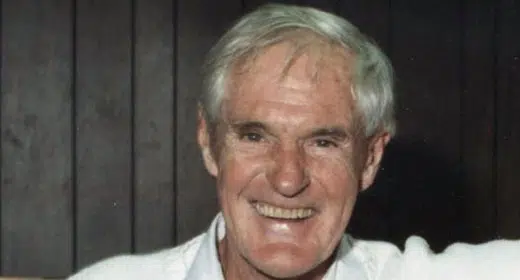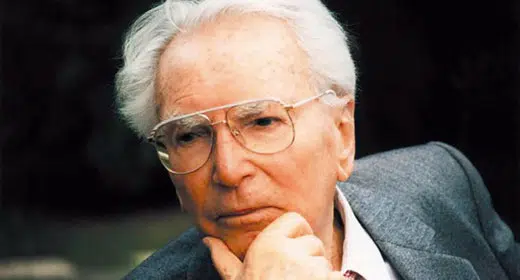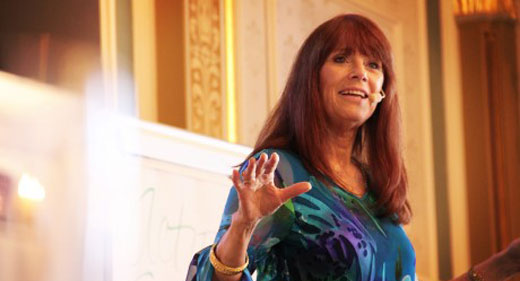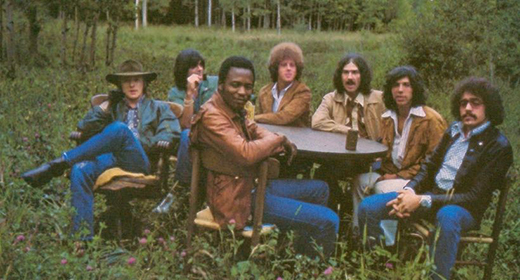by Steve Andreas: My wife Connirae and I visited Milton Erickson for a week about a year before he died.  At that time Erickson was very well-known, and could have charged a lot of money for these group sessions, but he only charged $40/hour—divided by the number of people visiting—which worked out to only about $4/hour per person!
At that time Erickson was very well-known, and could have charged a lot of money for these group sessions, but he only charged $40/hour—divided by the number of people visiting—which worked out to only about $4/hour per person!
At that time Connirae and I had been living together for four years, but had not yet married. By way of introduction, and in hope that it might help induce Erickson to allow us to come for a visit, I had sent him a copy of my book Awareness.
When we arrived at his small meeting room, along with 6 or 8 others, my book was on the coffee table, with a pen on top. Either later that day, or perhaps the next, Erickson held up the book with the pen on top (which he could do only with great difficulty) and asked, “Is the implication clear?” I took the book and pen, and set them down separately on the table, and replied that I didn’t sign books, because I thought it was a meaningless ritual.
The next day I had the thought, “I know, I could sign Erickson’s name.” Soon after that, Erickson asked me, “And have you decided to sign the book yet?” I replied, “Yes, as a matter of fact, I have,” and at the end of the day I signed the book, “Milton H. Erickson.”
At the end of the last day, Erickson was signing books for people in his small office, when a woman picked up my book, opened the cover, and said with surprise, “You signed Erickson’s name!” Erickson raised his head from his book signing, and looked up at me silently with one of the strangest expressions I have ever seen, and which I have never found words to adequately describe. The closest I can come to a description is that it was a sort of mixture of surprise, outrage, and demand.
Though I have no solid proof, I’m quite sure that Erickson somehow arranged for the woman to pick up the book and read the inscription, and that he had planned the look that he gave me. After all that orchestrated hard work, I decided to give in; I wrote “For” before his name, and followed it with “with great respect,” and then signed my name, which at that time was John O. Stevens.
At some point in the week, Erickson said something that stuck in my mind like a burr under a saddle blanket: “Marry an ugly woman, and she’ll always be grateful.” My thought at the time was, “What a stupid, sexist thing to say! Why on earth would he say something like that? I’m sure that isn’t true.” Was this simply a probe, so that he could notice how each of us in the group reacted? I don’t know if he was directing that comment to me; I only know that I still recall it very vividly, and Connirae didn’t remember it at all, so it wasn’t about her. Perhaps it was just a way to deliver an embedded command to “marry a woman,” while distracting my conscious mind with the sexism. Unmarried couples who went to see Erickson often found themselves married soon after.
Twenty years later, when I understood verbal implication better, I realized there was also an implied message, “Marry a beautiful woman, and she won’t always be grateful.” Most people think Connirae is quite beautiful—even now, over thirty-five years later. So the message may have been alerting me to be realistic; no member of a couple, beautiful or not, is always going to be grateful. Members of a couple often have unrealistic expectations about each other, and often the main theme is that the partner will provide what each feels to be missing in themselves. At that time, I certainly wasn’t as grateful as I could have been, and even now it is not a strong point. I’ll probably never know; I think that even those who spent years with Erickson, or who have studied his work extensively, understand only a very small fraction of what he did.
At another point, Erickson posed a question to us all: “Can you tell when someone is hypnotized?” Somehow I knew this was a trick question, so I kept my mouth firmly shut. Others offered a number of criteria. “Well there is “Spiegel’s sign” where the eyeballs tend to rotate upward.” “Their movements tend to be slower and more jerky.” “As someone goes into trance, first their face often becomes asymmetrical, and later more symmetrical,” etc. Erickson listened with total attention to each of these answers. Then when the flow of responses gradually slowed and stopped, he turned to a woman several seats to his right in the circle and said, “Where are we, Mary?” She responded in a high-pitched voice that might have belonged to a child of 5 or so, “Up in the apple tree.” Then Erickson said, “And what’s my name?” and she answered in the same sing-song childlike voice, “Tom-my.”
We had all understood Erickson’s question as intellectual and theoretical, but what he was really asking was, “Can you tell when someone is hypnotized—right here and now.” Erickson wanted us all to pay more attention to what was happening in the moment, and he didn’t mind rubbing our noses in our ignorance in order to make the point.
During the week there were different people on different days; some would come in for only a day or two, and others would come in on other days. One morning, a young woman appeared and sat a few seats to Erickson’s left. She was dressed from head to toe in purple—from the bow in her hair to her shoes and stockings. It was an unusual outfit, but purple was the only color that Erickson could see well. It didn’t take great observational skills to conclude that that this woman was a “people pleaser” who could use more self-direction.
About half-way through the morning, Erickson mentioned that because of having polio twice, he was almost completely color-blind, but sometimes he could distinguish colors based on faint cues. Then he turned to the person on his right and said, “For instance, I think that your plaid shirt is mostly made up of different shades of light yellow and brown, except for one thin line of dark red.” Then he proceeded to describe, with perfect accuracy, the colors in the clothing of the next person in the circle. He slowly worked his way around the room, never making a single mistake in naming the colors.
This took him a while, and he didn’t seem to be in any rush about it. When he finally got to the woman in purple, he paused for a moment, and looking bewildered said, “But I have no idea what color your dress is.” You have never seen anyone go into such a profound confusion state as she did, and she was literally speechless. Erickson immediately followed with, “Would you please tell me?” This request for her to speak while she was already so confused and unable to talk compounded her confusion exponentially. Erickson then offered her some suggestions that invited her to pay more attention to her own needs, rather than looking outside herself to others for approval.
This is an example of how Erickson often planned far ahead in his interventions, so that he could carefully frame and amplify his message to make it really impactful. If Erickson had simply commented on the woman’s dress at the beginning of the session, it would have had only a tiny fraction of the impact that it had after all the build-up of talking about being color-blind, and then naming colors correctly all around the circle.
At that point in my evolution, I usually couldn’t follow what Erickson was doing. Periodically Erickson would do something like the examples above, but even then I often had no idea how he had achieved it, so most of the time I was bored, and wasn’t interested in returning to see Erickson again. However, Connirae went back a few months later to spend another week with Erickson, and the following is her description of her experience during that week.
“At the time of my second visit to Dr. Erickson, I was dealing with a very difficult personal issue regarding my relationship with Steve, and wasn’t sure if our relationship would work out. My friend who had organized the week with Erickson encouraged me to ask Dr. Erickson for a private session, since he had helped her with a similar couples issue during the past year. I felt more than a bit intimidated by the famous Dr. Erickson, but on the first day we were there, when I said ‘Hello’ and introduced myself, I got my courage up and asked him if he would work with me privately. He said ‘Yes,’ smiling and nodding his head, but then he turned away without anything further—no explanation about how to set up an appointment, no next step. I was confused.
“Everyone was getting seated, and Erickson was definitely ‘in charge,’ so I didn’t ask any questions, but waited for him to let me know when this private session would happen. During the morning group session, at some point Erickson mentioned offhand and with a big smile, that his license had expired, so he could no longer work with anyone privately.
“Now I was really confused! Was he really going to work with me, then? Maybe he had meant he would use me as a demonstration person in the small group. This thought gave me a little reassurance, so every time he demonstrated a trance technique with someone, I did my best to be responsive. I noticed that he sometimes demonstrated with the person sitting next to him in the small circle. So the next day I made sure I sat in that place, but he didn’t work with me. The next day, when I sat farther away, he finally did use me as a demonstration person, but nothing much happened. Once more I was disappointed. Each day I would get my hopes up, and each day I was disappointed.
“Finally, on the last day, I gave up. I resigned myself to not getting anything for myself personally, so I thought I may as well just learn as much as I could about what he was doing with others during this last session. Instead of trancing out, I stayed alert and watched for the nonverbal marking out of messages, etc., that Erickson was doing with everyone else.
About an hour or more into the morning, as I sat there, all of a sudden I felt like I was a different person—that’s the only way I know how to describe it. Within a matter of seconds, I suddenly felt like I had never felt before. I still don’t know how to put it into words, but looking back on it I felt a sense of complete well-being. Plus I had a kind of wordless inner knowing that whatever happened, I would be OK—things would be fine no matter what. I had never felt that way before, in such a complete way. I assumed the man sitting on the other side of the circle in the purple pajamas had something to do with this, but I sure didn’t have any idea how.
“At this moment, Erickson looked straight at me and said in his slow, rhythmic voice, ‘And your unconscious mind has just made an important decision.’ (OK, so that’s pretty clear—he not only had something to do with this, he knew exactly when it happened!) ‘And you don’t know what it is,’ which is exactly what I was thinking. I thought about the major issue that I had been in such turmoil about, and realized I still didn’t have a clue what I would do, or how I would solve the situation. But somehow I knew, on a very visceral level, that things would be fine. More than fine really—it was a kind of deep peace with whatever could happen.
“Then the thought went through my mind, ‘I’m not sure if I would have anything to work with him about—maybe I don’t need a private session now.’
“And that was the moment Erickson asked, ‘And do you still feel a need to work with me privately?’
“I said, ‘No, I don’t think so.’ I was still very puzzled. I didn’t know what had happened, and I had no idea what I was going to do about my life situation. Yet I had a knowing that it was handled.
“Over the next several weeks, this feeling of well-being and clarity stayed with me very strongly. What I needed to do gradually came to me over the next several days, without any conscious thinking or planning. My experience was that it sort of ‘bubbled up’ without my doing anything. When I was clear what I needed to do, I carried it out in a way that felt more congruent than I can remember ever having felt before. Even though it was something difficult, I felt I could act from a place of love and respect, and without an attachment to what would happen as a result.”**
This is yet another example of Erickson’s planning, this time over a period of five days. We both assume that he was noticing how Connirae was responding to the different topics brought up during that time, to understand the structure of what was going on for her. Connirae and I both think it is no accident that the main intervention/change happened after she had “given up hoping.” So Erickson did work with Connirae privately after all; it was so private that even her conscious mind wasn’t invited to the session!
Within the next year we were married, I had changed my name to Steve Andreas, and Connirae was pregnant with our first child—something that happened to quite a number of couples soon after they went to see Erickson. *
Notes of Interest:
* It is worth noting that not all couples who went to see Erickson ended up with this scenario of marriage and family. A much smaller, yet not insignificant number, went away with a clarity that they needed to split up and go their separate ways. Our assumption is that Erickson had a way of tuning in to the particular couple’s relationship and compatibility.
** Connirae says,
“This experience with Dr. Erickson is what is started me on a search for what I later called the “Core Transformation Process.” The deep feeling of well-being I had then is the same as a “Core State”—what we come to fairly easily through CT—but I was very disappointed when the deep well-being I had for a few weeks began to fade after that, and determined to find some way to experience that as an ongoing basis of living.”









































